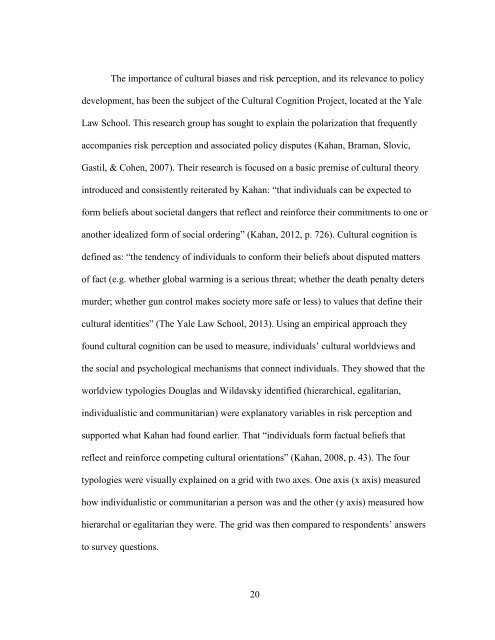PERCEIVED RISK AND THE SITING OF A CONTROVERSIAL ...
PERCEIVED RISK AND THE SITING OF A CONTROVERSIAL ...
PERCEIVED RISK AND THE SITING OF A CONTROVERSIAL ...
Create successful ePaper yourself
Turn your PDF publications into a flip-book with our unique Google optimized e-Paper software.
The importance of cultural biases and risk perception, and its relevance to policy<br />
development, has been the subject of the Cultural Cognition Project, located at the Yale<br />
Law School. This research group has sought to explain the polarization that frequently<br />
accompanies risk perception and associated policy disputes (Kahan, Braman, Slovic,<br />
Gastil, & Cohen, 2007). Their research is focused on a basic premise of cultural theory<br />
introduced and consistently reiterated by Kahan: “that individuals can be expected to<br />
form beliefs about societal dangers that reflect and reinforce their commitments to one or<br />
another idealized form of social ordering” (Kahan, 2012, p. 726). Cultural cognition is<br />
defined as: “the tendency of individuals to conform their beliefs about disputed matters<br />
of fact (e.g. whether global warming is a serious threat; whether the death penalty deters<br />
murder; whether gun control makes society more safe or less) to values that define their<br />
cultural identities” (The Yale Law School, 2013). Using an empirical approach they<br />
found cultural cognition can be used to measure, individuals’ cultural worldviews and<br />
the social and psychological mechanisms that connect individuals. They showed that the<br />
worldview typologies Douglas and Wildavsky identified (hierarchical, egalitarian,<br />
individualistic and communitarian) were explanatory variables in risk perception and<br />
supported what Kahan had found earlier. That “individuals form factual beliefs that<br />
reflect and reinforce competing cultural orientations” (Kahan, 2008, p. 43). The four<br />
typologies were visually explained on a grid with two axes. One axis (x axis) measured<br />
how individualistic or communitarian a person was and the other (y axis) measured how<br />
hierarchal or egalitarian they were. The grid was then compared to respondents’ answers<br />
to survey questions.<br />
20
















